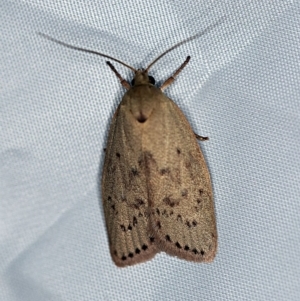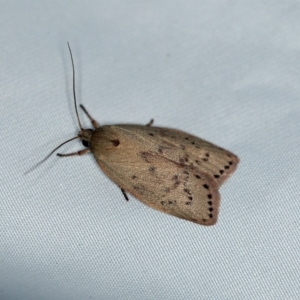A concealer moth at O'Connor, ACT
Identification history
| Heliocausta undescribed species | 17 Aug 2019 | ibaird | ||
| Heliocausta undescribed species | 16 Aug 2019 | donhe | ||
| Heliocausta oecophorella | 7 Aug 2019 | ibaird |
Identify this sighting
Please Login or Register to identify this sighting.
User's notes
Attracted to UV led light at night.
5 comments
GlennCocking
wrote:
17 Aug 2019
I think it better matches a Heliocausta species that is common in ACT and elsewhere on the southern tablelands. H. oecophorella is mainly a southern SA and WA moth. We have one report previously assigned to that species, although the base colours presented in the photos are quite different.
donhe
wrote:
17 Aug 2019
The BOLD webpage for H. oecophorella shows it clustered around NSW with outliers extending from Qld to Tas, SA, and WA., and shows very wide variations of forewing patterns from yellow with a large brown tornal patch to entirely brown with some dark spots to plain brown.
Is it sexually dimophic?
The intra-species variablity seems to exceed the inter-species variation, so I do not see how we can possibly determine the species from a photo.
Is it sexually dimophic?
The intra-species variablity seems to exceed the inter-species variation, so I do not see how we can possibly determine the species from a photo.
GlennCocking
wrote:
17 Aug 2019
BOLD has put its Heliocausta into 5 Bins. The ones that have "forewing patterns from yellow with a large brown tornal patch" are all in the same bin, and they are from SA/WA. These are the ones that ANIC has placed under H. oecophorella, and I suspect I'll find they match the type description. The other specimens in this Bin and all the others are variations of brown with dark marks , and BOLD has called many of them H. oecophorella. The variation seems to be independent of sex. I agree we can't determine the species from a photo, and think we should call them H. sp.
donhe
wrote:
17 Aug 2019
I have put links to Walker's original description, and to Meyrick's descriptions of the synonyms H. paralyrgis and H. eudoxa at the foot of the webpage
http://lepidoptera.butterflyhouse.com.au/wing/oecophorella.html
My understanding of all three descriptions is that they all say yellow forewings with a brown area along the margin extending along the hind margin. Meyrick also describes some forewing dark spots for H. eudoxa,
but none of the three descriptions appear to mention the forewing marginal and submarginal arcs of dots apparent on this CNM 4231746 and on some of the BOLD specimens.
Maybe I am missing something?
Common in his Wingia Group book, on p. 271 fig. 501, has a photo of a specimen with forewings each having a marginal arc of spots and some submarginal spots, which he notes as Helicausta sp.
http://lepidoptera.butterflyhouse.com.au/wing/oecophorella.html
My understanding of all three descriptions is that they all say yellow forewings with a brown area along the margin extending along the hind margin. Meyrick also describes some forewing dark spots for H. eudoxa,
but none of the three descriptions appear to mention the forewing marginal and submarginal arcs of dots apparent on this CNM 4231746 and on some of the BOLD specimens.
Maybe I am missing something?
Common in his Wingia Group book, on p. 271 fig. 501, has a photo of a specimen with forewings each having a marginal arc of spots and some submarginal spots, which he notes as Helicausta sp.
GlennCocking
wrote:
21 Aug 2019
The evidence suggests Heliocausta sp is the best identification. It seems that the yellow form with a dark fw termen with an inwards extension( as illustrated on Butterfly House) is H. oecophorella, and the many brownish/reddish specimens with small dark marks may be H. oecophorella or even one of the other two named species, but most likely one of many potential unnamed species. ANIC has many specimens of such forms, including plenty of one from Black Mountain.
Please Login or Register to comment.
Nearby sightings
Location information
- Coordinates 149.113158-35.259584
- Altitude 589.7m
- Places O'Connor, ACT
Sighting information
- 1 Abundance
- 18 Nov 2018 11:12 PM Recorded on
- ibaird Recorded by
Additional information
- 12mm to 25mm Animal size
Species information
- Heliocausta undescribed species Scientific name
- A concealer moth Common name
- Not Sensitive
- Local native
- Non-Invasive
- Up to 1646.02m Recorded at altitude
- Machine learning
- External link More information
Record quality
- Overall Fit for scientific/research use
- Images or audio
- More than one media file
- Confirmed by an expert moderator
- Nearby sighting(s) of same species
- GPS evidence of location
- Description
- Additional attributes



























































